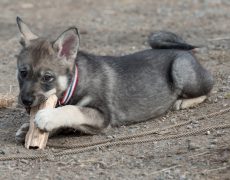Jämthund
The Jämthund, also known as the Swedish Elkhound, is a breed of medium-sized, Spitz type, hunting dogs with wolf-like markings. It is a strong, rectangular, agile dog that has a good stature, slightly arched skull, evenly tapering muzzle, somewhat oval eyes, perfectly erect, pointed, high-set ears, long neck, deep chest, well-sprung ribs, long shoulder blades, strong, slightly oval feet, and a medium length, high set tail that is carried curled.
Jämthund Pictures
- Images of Jämthund
- Jämthund Dog
- Jämthund Images
- Jämthund Photos
- Jämthund Pictures
- Jämthund Puppies
- Jämthund
- Pictures of Jämthund
- Swedish Elkhound
- Swedish Moosehound
Quick Information
| Other Names | Swedish Moosehound |
| Coat | Close-lying topcoat, short, soft, light undercoat, smooth hairs at the front of legs and head |
| Color | Light and dark gray |
| Breed Type | Purebred |
| Group | Nordic Hunting Dogs, Northern Breed |
| Lifespan | Around 12-13 years |
| Weight | 50-66 lbs |
| Size | Medium |
| Height | Female: 20-24 in, Male: 22-26 in |
| Shedding | Moderate |
| Size of Litter | Around 6 puppies |
| Temperament | Loyal, active, calm, independent, courageous |
| Hypoallergenic | Unknown |
| Good with Children | Yes |
| Barking | Barks when required |
| Country Originated in | Sweden |
| Competitive Registration/ Qualification Information | FCI, UKC |
Video: Jämthund (Swedish Elkhound) Playing in the Snow
History
The Jämthund is one of the ancient Swedish breeds that originated in Jämtland province, thousands of years ago, due to a cross between a male dog and a female wolf. The dog characterized by a wolf-like appearance was developed to be exceptionally brave and powerful so that it could be used for hunting wolves, bears, and elks. While it primarily served as a hunting dog, the locals also kept it as a guard dog, sled dog, and family pet. Because of its versatility, stamina, and the ability to survive and work in a harsh climate, it gained immense popularity.
As it is closely related with other Scandinavian breeds, including the Swedish Lapphund, Norwegian Elkhound, and Finnish Lapphund, it was classified together with these breeds. It was in 1946 when the Swedish Kennel Club recognized this large Spitz-type dog as a separate breed. The recognition of the Jämthund was mainly because of the activism of Aksel Lindstrom. It got official recognition from the UKC in 2006.
Temperament and Behavior
The Swedish Elkhound is not known for being aggressive to humans and is usually affectionate with its people. Although an energetic breed, it remains stoically calm at home and is gentle with kids.
Because of its alert and protective nature, it does an excellent job in guarding its family and territory against danger. It can cope with or manage difficult situations well without getting ruffled easily, thus making a steady companion in the hunting field and at home.
It should not be trusted with small pets unless introduced to other animals at a young age. Since it has an innate hunting instinct, it should always be kept on a leash when in public places.
Care
Exercise
As with hunting breeds, the Jämthund needs regular activities outdoors to stay mentally and physically fit. It loves to roam freely in large, fenced yards and go for long hikes. If its exercise requirements are not met, it may become bored and develop destructive behaviors.
Grooming
Its coat should be regularly brushed to keep the undercoat from matting and remove dead hairs. Bathing it too often should be avoided, as regular washing may strip away the natural oils of its weather-resistant coat, making it dry.
Health Problems
While the Swedish Elkhound is considered a healthy breed, one or two individuals may develop certain health issues including hip dysplasia, skin allergies, elbow dysplasia, progressive retinal atrophy, and obesity.
Training
Because of its stubbornness and independent nature, it should be trained with firm and consistent methods. Being an intelligent dog, it can learn and respond to training quickly.
Socialization
Soon after bringing your Jämthund puppy home, start its socialization training by exposing it to other socialized dogs and pets. Train your puppy in a controlled environment first. You may invite friends who have healthy, friendly, vaccinated dogs to come and meet your pup at your home. Also, take your puppy to those friends’ homes.
Obedience Training
Make sure that your Swedish Elkhound knows some basic obedience commands including sit, come, leave it, stay, and down. Reward it with affection and treats every time it responds to your commands.
Feeding
The Jämthund should be fed a quality food formulated for hunting dogs of its age. A high-performance diet consisting of 30 percent protein and 20 percent fat may appropriately meet the needs of an active Swedish Elkhound.
Interesting Facts
- It is referred to as the “bear dog” in Jämtland dialects because it is one of the few dogs that do not draw back from the action while confronting a bear.
















I had a jämthund, who lived for nearly 15 years. She would stay close, but enjoyed “playing Houdini.” She would escape from the house or hide behind a structure on a walk, and when I called out, she would jump out and shake her head side to side in a dramatic fashion, as though to say, “I tricked you.” She would always return, but enjoyed “fooling me.” Not when hunting, though. She was very serious during the hunt. She is sorely missed.
I like to hike and bike off leash.
Is the Swedish elkhound good at staying close and
good on recall.
Hi Don,
The Swedish Elkhounds are bred for hunting, and they should be trained to obey commands including the recall. Although they are not velcro dogs, they are quick learners and obey their owners.